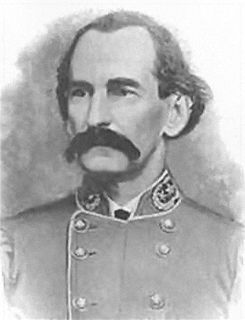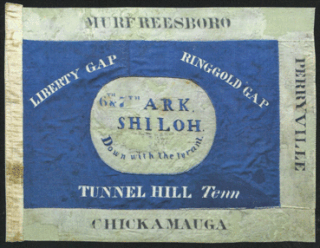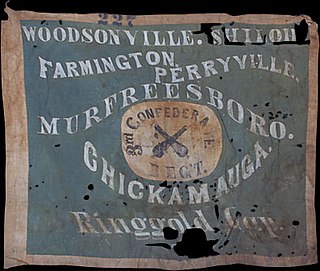| 9th Kentucky Infantry Regiment | |
|---|---|
| Active | October 3, 1861 – May 7, 1865 |
| Country | Confederate States of America |
| Allegiance | Confederate States Army |
| Branch | Confederate States Army Infantry & Mounted Infantry |
| Engagements | Battle of Shiloh Battle of Baton Rouge Battle of Hartsville Battle of Stones River Vicksburg Campaign Siege of Jackson Battle of Chickamauga Atlanta Campaign Battle of Rocky Face Ridge Battle of Resaca Battle of Dallas Battle of Kennesaw Mountain Battle of Peachtree Creek Battle of Atlanta Battle of Utoy Creek Battle of Jonesboro Sherman's March to the Sea Carolinas Campaign |
The 9th Kentucky Infantry Regiment was an infantry regiment that served in the Confederate States Army during the American Civil War. It was part of the First Kentucky Brigade.
The 9th Kentucky Infantry was organized October 3, 1861, in Bowling Green, Kentucky, under the command of Colonel Thomas H. Hunt and designated the 5th Kentucky Infantry; it did not complete organization until May 15, 1862. (It continued to be referred to as the 5th Kentucky Infantry or 5th (Hunt's) Kentucky Infantry during its existence and after the war.) Men were recruited in Harrison, Jefferson, Logan, Nelson, Ohio, and Scott counties. In 1863, Company I was transferred to the 5th Kentucky Infantry.
The regiment retreated to Corinth, Mississippi, after the Battle of Shiloh and was ordered to Vicksburg, Mississippi, to aid in the defenses there.
The regiment came under heavy fire at the Battle of Stones River on January 2, 1863. Having been ordered by Bragg to attack an area that division commander Maj. Gen. John C. Breckinridge had reconnoitered and determined to be too heavily defended, the First Kentucky Brigade led the charge. Although initially successful, the brigade was met by heavy Union Army artillery fire. Brigade commander Brig. Gen. Roger Hanson was also mortally wounded in the attack. The 9th Kentucky Infantry lost one killed and twenty-eight wounded in the battle.
Later that same year, the First Kentucky Brigade was ordered back to Vicksburg, to help relieve the siege. The brigade arrived after the fall of Vicksburg on July 4, 1863, and fell back to Jackson, Mississippi, where they were attacked in mid-July. At the Battle of Chickamauga the regiment lost 44% of its strength of 230 engaged. Weeks later, the 9th Kentucky Infantry was called upon to guard the Confederate army's retreat following the Battle of Missionary Ridge. The army retreated to Dalton, Georgia and went into winter quarters.
The First Kentucky Brigade became part of the Atlanta Campaign on May 7, 1864, when they left their winter camps and took up positions on Rocky Face Ridge. The regiment became part of the fighting retreating force as Maj. Gen. William T. Sherman pushed the Confederates further back toward Atlanta. At the Battle of Dallas near New Hope Church, the First Kentucky Brigade made an unsupported charge, losing 51% of its strength. At the Battle of Jonesboro on August 31, 1864, the brigade was ordered to attack the entrenched federal position. At an unseen deep ravine, the attack came to a halt. The following day, the Confederates were overwhelmed when two-thirds of a Union Army division attacked and began to surround their positions. Many of the men of the 2nd Kentucky Infantry, 6th Kentucky Infantry, and 9th Kentucky Infantry were captured. The remnants of the brigade fell back and managed a successful defense against the Union assault, bringing it to a halt. On September 4, only 500 men were present for duty in the entire First Kentucky Brigade.
The 9th Kentucky Infantry was afterward ordered to Griffin, Georgia and converted to mounted infantry. The regiment was engaged in delaying tactics during Sherman's March to the Sea, following him all the way to Savannah, Georgia, finally moving to Augusta, Georgia, in early 1865. The regiment's last engagement was on April 29, 1865, in a skirmish near Stateburg, South Carolina. The regiment was ordered to Washington, Georgia and surrendered on May 7, 1865.

The Battle of Hoover's Gap was the principal battle in the Tullahoma Campaign of the American Civil War, in which Union General William S. Rosecrans drove General Braxton Bragg’s Confederates out of Central Tennessee. Rosecrans’ feigned move on the western end of the Confederate line had left the eastern mountain passes lightly defended, and Colonel John T. Wilder's mounted infantry achieved total surprise when they attacked Hoover's Gap. Success was attributed both to Rosecrans’ brilliant deception tactics and the high morale of Wilder’s ‘Lightning Brigade’, equipped with the new Spencer repeating rifle, which totally disoriented the enemy.
The 2nd Ohio Volunteer Infantry was an infantry regiment in the Union Army during the American Civil War.
The 10th Ohio Volunteer Infantry was an infantry regiment in the Union Army during the American Civil War. The regiment was also known as the "Montgomery Regiment," and the "Bloody Tenth". The 10th Ohio Infantry was predominantly recruited from Irish Americans, but had two companies consisting of German Americans.

The 11th Michigan Volunteer Infantry, initially known as Colonel May’s Independent Regiment, was a unit in the Union army during the American Civil War. The regiment fought with the Army of the Cumberland in numerous battles, including Stones River, Chickamauga, and Missionary Ridge.
The 21st Regiment Illinois Volunteer Infantry was a volunteer infantry regiment that served in the Union Army during the American Civil War.
The 22nd Regiment Alabama Volunteer Infantry was an infantry regiment that served in the Confederate Army during the American Civil War.

1st Arkansas Mounted Rifles (1861–1865) was a Confederate Army cavalry regiment during the American Civil War. The unit was formed as a mounted infantry regiment, but was dismounted in the spring of 1862 and remained dismounted for the remainder of the war. The unit participated in the earliest battles in the western theater at Wilson's Creek and surrendered with the remnants of the Army of Tennessee in North Carolina in April 1865.
The 21st Ohio Volunteer Infantry was an infantry regiment in the Union Army during the American Civil War. Mostly an all-volunteer unit, with the exception of a few draftees, the 21st Ohio served for both ninety-day and three-year enlistments and fought exclusively in the Western Theater. It saw action in some of the war's bloodiest battles including Stones River, Chickamauga, the Atlanta Campaign, and Sherman's March to the Sea.

Marcellus Augustus Stovall was an American soldier and merchant. He served as a Confederate general during the American Civil War, and later he resumed business and civil interests.

The 18th Georgia Volunteer Infantry was an infantry regiment in the Confederate Army during the American Civil War. Originally brigaded with the three Texas regiments of John Bell Hood's Texas Brigade, it was transferred to Thomas R.R. Cobb's Georgia Brigade after the Battle of Antietam in late 1862. After General Cobb was mortally wounded at the Battle of Fredericksburg, the original colonel of the 18th Georgia, William T. Wofford, became Brigadier General of the Georgia Brigade.

The 4th Kentucky Infantry Regiment was an infantry regiment that served in the Confederate States Army during the American Civil War. It was part of the First Kentucky Brigade.
The 5th Kentucky Infantry Regiment was an infantry regiment that served in the Confederate States Army during the American Civil War. In 1863 it became part of the First Kentucky Brigade.
The 6th Kentucky Infantry Regiment was an infantry regiment that served in the Confederate States Army during the American Civil War. It was formed from Nelson, Barren, and surrounding counties. It was also part of the First Kentucky Brigade.

The 7th Arkansas Volunteer Infantry (1861−1865) was a Confederate Army infantry regiment during the American Civil War. Organized mainly from companies, including several prewar volunteer militia companies, raised in northeastern Arkansas, the regiment was among the first transferred to Confederate service, and spent virtually the entire war serving east of the Mississippi River. After the unit sustained heavy casualties in the Battle of Shiloh and the Kentucky Campaign, the unit spent most of the rest of the war field consolidated with the 6th Arkansas Infantry Regiment to form the 6th/7th Arkansas Infantry Regiment.

William J. Carson was a United States Army soldier and recipient of the United States' highest military decoration, the Medal of Honor, for his actions at the Battle of Chickamauga in the American Civil War.
The 31st Arkansas Infantry (1862–1863) was a Confederate Army infantry regiment during the American Civil War from the state of Arkansas. The 31st Arkansas served throughout the war in the western theater, seeing action in the Kentucky, Tennessee and Georgia campaigns. Following its depletion in numbers the regiment was consolidated several times with other Arkansas regiments, finally merging in 1865 into the 1st Arkansas Consolidated Mounted Rifles.

The 25th Arkansas Infantry was an infantry regiment of the Confederate States Army during the American Civil War. The unit was originally organized as Turnbull's 11th Arkansas Infantry Battalion. Upon being increased by the required number of companies the battalion was organized as the 30th Arkansas Infantry Regiment but was later redesignated as the 25th Arkansas Infantry. There were two regiments officially designated as the 30th Arkansas Infantry. The other "30th Arkansas" served west of the Mississippi River, in the Department of the Trans-Mississippi and was also known as 5th Trans-Mississippi Regiment or the 39th Arkansas or Rogan's Arkansas Cavalry during Price's 1864 Missouri Expedition.
The 15th Arkansas Infantry Regiment (Josey's) (1861–1865) was a Confederate Army infantry regiment that served during the American Civil War. The regiment was organized in May 1861 under the command of Colonel Patrick Cleburne. It served throughout the war in the western theater, seeing action in the Kentucky, Tennessee, and Georgia campaigns. Following its depletion in numbers the regiment was consolidated several times with other Arkansas regiments, finally merging in 1865 into the 1st Arkansas Consolidated Infantry Regiment. There were two other regiments which also received the designation of "15th Arkansas". The 21st (McRae's) Arkansas Infantry was redesignated 15th Arkansas in February 1863, but to avoid confusion, was normally referred to as the 15th (Northwest) Arkansas Infantry Regiment. This second "15th Arkansas" was surrendered at Vicksburg in July 1863. A third regiment, under command of Colonels Gee and later Johnson, also received the designation 15th Arkansas Infantry. This last regiment surrendered at Port Hudson, Louisiana, in July 1863.

The 18th Arkansas Infantry (Marmaduke's) (1861–1865) was a Confederate Army infantry regiment during the American Civil War. The unit was also briefly identified as the 1st Arkansas Infantry Battalion. The unit was most often referred to as the 3rd Confederate Infantry Regiment. The designation "Confederate Infantry Regiment" was intended to convey the difference between Provisional Confederate Army units and Regular Confederate Army Units, with Provisional units being those regiments who received a state designation such as "XX Arkansas Infantry Regiment". In practice, the designation was most often utilized when Regiments were assembled utilizing companies from more than one confederate state. The "3rd Confederate Infantry Regiment" is occasionally misidentified as the 3rd Arkansas Infantry Regiment commanded by Colonel Van H. Manning.

The 9th Texas Infantry Regiment was a unit of Confederate States Army infantry volunteers organized in December 1861 that fought during the American Civil War. The regiment fought at Shiloh, Perryville, and Stones River in 1862, Chickamauga in 1863, the Atlanta Campaign, Allatoona, and Nashville in 1864, and Spanish Fort and Fort Blakeley in 1865. The remaining 87 officers and men surrendered to Federal forces in May 1865. Two of the regiment's commanding officers were promoted brigadier general.